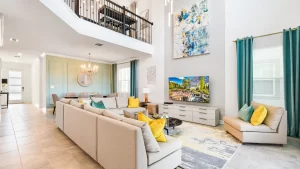The hospitality industry is constantly evolving to meet the needs and expectations of its guests. One of the most important aspects of this evolution is interior design.
Designers are always looking for new and innovative ways to create spaces that are both stylish and functional. In this article, we will discuss 5 of the latest trends in hospitality interior design.
-
Biophilic design
Biophilic design is a growing trend in interior design that focuses on connecting people with nature. This can be done by using natural materials, such as wood and stone, as well as incorporating plants, water features, and natural light into the design.
Biophilic design has been shown to have a number of benefits for guests, including reduced stress levels, improved sleep quality, and increased creativity.
-
Experiential design
Experiential design is all about creating spaces that tell a story and evoke an emotional response from guests.
This can be done by using themed décor, interactive elements, and sensory experiences. Experiential design is a great way to create a unique and memorable experience for guests.
-
Technology-infused design
Technology is playing an increasingly important role in hospitality interior design. Vacation homes are using technology to create more personalized and convenient experiences for their guests.
This includes things like smart TVs, voice-activated controls, and mobile apps. Technology can also be used to create interactive and immersive experiences.
-
Sustainable luxury design
Sustainability is becoming increasingly important to both guests and vacation home managers. Vacation homes are using a variety of sustainable design practices to reduce their environmental impact.
This includes things like using energy-efficient appliances, incorporating recycled materials, and conserving water. Sustainable design is not only good for the environment, but it can also save home vacation money in the long run.
-
Wellness-focused design
Wellness is another important trend in hospitality interior design. Creating spaces that promote health and well-being is crucial.
This refers things like fitness centers, spas, and yoga studios. Hotels are also offering wellness amenities, such as healthy food options and in-room aromatherapy.
These are just a few of the many innovations that are shaping the future of hospitality interior design. As the industry continues to evolve, we can expect to see even more creative and innovative designs that will enhance the guest experience.
Luxury hospitality is as much about the experience as it is about the accommodation. Designers are integrating art and cultural elements into their designs to create unique and authentic experiences for guests.
Whether it’s showcasing local artists or incorporating traditional craftsmanship, art and culture are integral to luxury hospitality interior design.
In addition to the trends discussed above, here are a few other things to keep in mind when designing a hospitality space:
- The target audience: Who are you designing the space for? What are their needs and expectations?
- The budget: How much money do you have to spend on the project?
- The location: Where is the hotel located? What are the local design trends and influences?
By considering all of these factors, you can create a hospitality space that is both stylish and functional and that will meet the needs of your guests.







